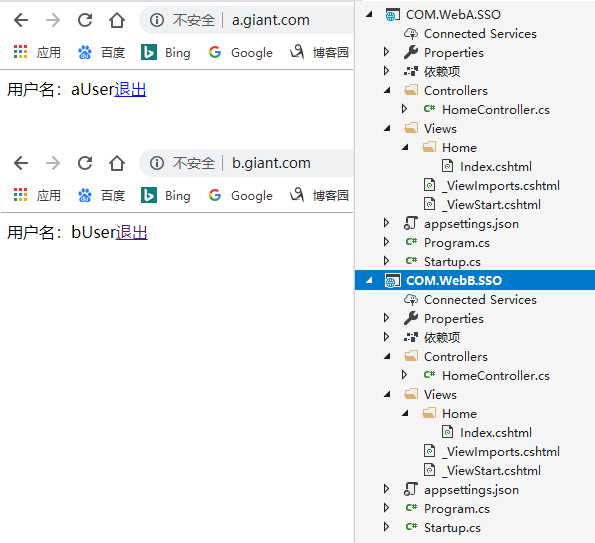在同一個功能變數名稱下有很多子系統 如:a.giant.com b.giant.com c.giant.com等 但是這些系統都是giant.com這個子域。 這樣的情況就可以在不引用其它框架的情況下,直接基於Cookie實現同域單點登錄SSO 註:用ID4,OAuth,其它SSO框架也同樣可以實現。本文不 ...
在同一個功能變數名稱下有很多子系統
如:a.giant.com b.giant.com c.giant.com等
但是這些系統都是giant.com這個子域。
這樣的情況就可以在不引用其它框架的情況下,直接基於Cookie實現同域單點登錄SSO
註:用ID4,OAuth,其它SSO框架也同樣可以實現。本文不討論。
為了簡單表示。在這裡登錄頁只輸入一個用戶名,然後登錄
後臺接收到登錄名後,構建登錄信息。然後登錄
代碼如下:
<form enctype="application/x-www-form-urlencoded" method="post"> @if (!User.Identity.IsAuthenticated) { <div><label>用戶名:<input type="text" name="UserName" /></label><button type="submit">登錄</button></div> } else { <div><label>用戶名:@User.Identity.Name</label><a href="/Home/SignOut">退出</a></div> } </form>
public class HomeController : Controller { public IActionResult Index() { return View(); } [HttpPost] public async Task<IActionResult> Index(string UserName) { var claims = new List<Claim> { new Claim(ClaimTypes.Name, UserName) }; var claimsIdentity = new ClaimsIdentity(claims, CookieAuthenticationDefaults.AuthenticationScheme); await HttpContext.SignInAsync(CookieAuthenticationDefaults.AuthenticationScheme, new ClaimsPrincipal(claimsIdentity)); return RedirectToAction("Index"); } public async Task<IActionResult> SignOut() { await HttpContext.SignOutAsync(CookieAuthenticationDefaults.AuthenticationScheme); return RedirectToAction("Index"); } }
public class Startup { public void ConfigureServices(IServiceCollection services) { services.AddAuthentication(CookieAuthenticationDefaults.AuthenticationScheme).AddCookie(); services.AddMvc().SetCompatibilityVersion(Microsoft.AspNetCore.Mvc.CompatibilityVersion.Version_2_2); } // This method gets called by the runtime. Use this method to configure the HTTP request pipeline. public void Configure(IApplicationBuilder app, IHostingEnvironment env) { if (env.IsDevelopment()) { app.UseDeveloperExceptionPage(); } app.UseAuthentication(); app.UseMvcWithDefaultRoute(); } }
這樣就可以實現一個子系統的簡單登錄,效果如下
同樣創建一個COM.WebB.SSO,寫同樣的代碼實現登錄。
但是這樣只能A站點登錄A系統,B站點登錄B系統。兩個系統相互獨立

如果我們要實現aUser登錄A系統後,B系統也自動登錄aUser。
那麼就可做如下改造
public void ConfigureServices(IServiceCollection services) { services.AddDbContext<SSOContext>(option => { option.UseSqlServer(Configuration.GetConnectionString("SSO")); }); services.AddDataProtection() .PersistKeysToDbContext<SSOContext>() //把加密數據保存在資料庫 //.PersistKeysToFileSystem(new DirectoryInfo(@"\\server\share\directory\")) //把加密信息保存大文件夾 .SetApplicationName("SSO"); //把所有子系統都設置為統一的應用名稱 services.AddAuthentication(CookieAuthenticationDefaults.AuthenticationScheme) .AddCookie(CookieAuthenticationDefaults.AuthenticationScheme,options=> { options.Cookie.Name = ".AspNet.SharedCookie";//設置統一的Cookie名稱 options.Cookie.Domain = ".giant.com";//設置Cookie的域為根域,這樣所有子域都可以發現這個Cookie }); services.AddMvc().SetCompatibilityVersion(Microsoft.AspNetCore.Mvc.CompatibilityVersion.Version_2_2); }
主要是增加了services.AddDataProtection配置
其中,數據加密配置保存方式現階段asp.net Core支持
1。保存到文件:PersistKeysToFileSystem
2。保存到資料庫:PersistKeysToDbContext<Context>
3。保存到Redis:PersistKeysToStackExchangeRedis
4。保存到Azure:PersistKeysToAzureBlobStorage
當然也可以自己實現存儲方式,實現IXmlRepository
我這裡實現了保存到資料庫,代碼如下:
public class SSOContext : DbContext, IDataProtectionKeyContext { public SSOContext(DbContextOptions<SSOContext> option) : base(option) { } public DbSet<DataProtectionKey> DataProtectionKeys { get; set; } }
主要就是在DbContext基礎上實現介面:IDataProtectionKeyContext
這裡修改配置主要統一了數據加密方式與統一應用名稱
這樣其它子域的Cookie加密數據就能識別。
再配置統一的Cookie名稱與寫的功能變數名稱為根域。
這樣所有子域都能發現與識別此登錄的Cookie信息
這樣就可以實現一個系統登錄,其它子系統都登錄
一個子系統退出。其它子系統也都退出的功能
源代碼下載地址:https://github.com/GiantLiu/COM.SSO


